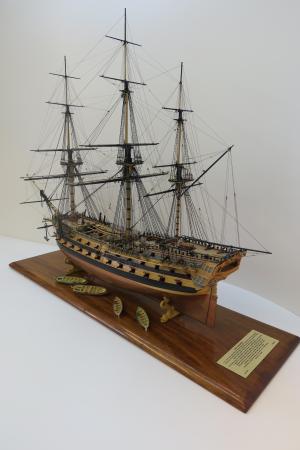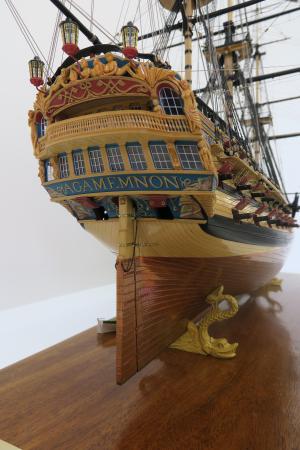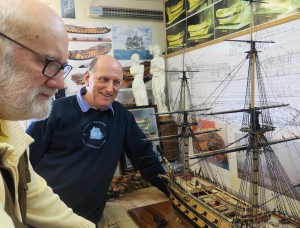Agamemnon: the Darch Model
Devon-based Malcolm Darch has just completed a magnificent 1:64 scale model of HMS Agamemnon. His 57th commission, she was built for a private collector in the UK and just before she was shipped to her new home Kathy and I were honoured to be invited to a private viewing. I have had the privilege of seeing many fine ship models over the years but I have to say this one of Agamemnon is up there at the top, quite exquisite in appearance and the attention to the tiniest detail truly incredible. She’s a work of art in every sense, a unique homage to the beauty of the fighting ship under sail.
— ♥ —
From shipwright to model maker

Malcolm trained as a shipwright (about the same time as myself) on the world-famous Hamble river in the 1960s. After ten years in the trade he started building showcase models in Salcombe, Devon, where he still works in a sun-lit studio on the waterfront. He specialises in 19th and early 20th century ship models. Malcolm’s previous works include the steel barques Moshulu and Pamir, Tern III, Claud Worth’s famous cruising yacht and the frigate Minerva of 1780. Most of Malcolm’s models are in private hands but several years ago he was commissioned to build 1.24th scale models of the local RNLI’s entire fleet (from 1869 to the present day) and these are on display at the Salcombe Lifeboat House Museum.
Nelson’s favourite
HMS Agamemnon was a 64-gun third-rate ship-of-the-line of the Royal Navy. She saw service in the American Revolutionary, French Revolutionary and Napoleonic Wars and fought in many of the major naval battles of those conflicts. She is remembered as being Nelson’s favourite ship and was named after the mythical ancient Greek king Agamemnon, the first ship of the Royal Navy to bear the name. To her crew she was known affectionately as ‘Eggs and Bacon’.
Nelson served as Agamemnon‘s captain from January 1793 for 3 years and 3 months, during which time she saw considerable service in the Mediterranean. After Nelson’s departure, she was involved in the 1797 mutinies at Spithead and the Nore, and in 1801 was present at the first Battle of Copenhagen, but ran aground before being able to enter the action.
She fought at the Battle of Trafalgar on 21 October 1805, as part of Nelson’s weather column, where she forced the surrender of the Spanish four-decker Santssima Trinidad. Agamemnon‘s later career was served in South American waters off Brazil.
Sadly she was wrecked in June 1809 on an uncharted shoal in the mouth of the River Plate, whilst seeking shelter with the rest of her squadron from a storm. Recently, the wreck of Agamemnon has been located, and several artefacts have been recovered, including one of her 24lb cannon.
Research, research, research
 Malcolm’s research for this project included assistance from the National Maritime Museum staff; Christine Hyack, a researcher at the National Archive; The National Maritime Museum; and Chatham Staff with their collection of ship models.
Malcolm’s research for this project included assistance from the National Maritime Museum staff; Christine Hyack, a researcher at the National Archive; The National Maritime Museum; and Chatham Staff with their collection of ship models.
He also consulted the Archivist with the Montagu Estate at Bucklers hard, Agamemnon‘s place of build in 1781, though, the model is shown during the period of Nelson’s command 1793 to 1796. The Admiralty order to cease frieze painting came through in 1795, and so Agamemnon would have lost her decoration upon the vessel returning to England when she had to undergo a refit in 1796. The Admiralty order to rearm ships of the line with carronades on the poop deck was being considered in 1796. It was the client’s wish to include them, his being a student of Nelson’s career led him to feel that if Nelson could have managed to get hold of some, he was sure he would have, regardless of the ongoing discussions at the Admiralty.
The research (which took 8 months, before any timber was cut) included compiling a set of drafts for Agamemnon using copies of the original drafts of over half a dozen similar men-of-war. (No original drafts for Agamemnon have surfaced yet)
Peeking through the windows
One of the fascinating features of the model is the detail that can be viewed by peeking through the windows of the ship. The main gun deck, fully fitted out with rigged 24lb cannon, pumps, capstans ladders etc., are visible through the stern chase ports. The upper gun deck and quarter deck, likewise fully fitted out, are visible through the stern windows.
The rigging was spun by William Mowll of Kent on his model ropewalk to the required specifications of dimensions colour and lay. The model is made entirely of boxwood including all the figure carving and intricate mouldings.
An ornate painted frieze runs the length of the vessel incorporating the story of Agamemnon and the Trojan wars brought about by his sister-in-law Helen being kidnapped by Paris and taken to Troy. The neo classical frieze (which gives the impression that the illustrations are in relief with the use of light & shaded colours) on the beak bulkhead contains images of the head of the wooden horse, also Achilles and Hector plus the usual rendering of weapons and flags. The frieze painting took 260 hours and wore out three 00000 sable brushes!
The figure carving. all in boxwood. incorporates Agamemnon as the figurehead, with the conception of Helen in the starboard trailboard at his feet (Leda & the Swan). The port trailboard shows his wife upon his return home after many years away fighting the war, about to kill him in the pool with a spear. She had taken a lover during his absence who persuaded her to do this terrible deed.
The stern carving was researched from a painting by Nicholas Pocock of the stern of the ship painted at Chatham in 1784 from life, whilst undergoing repairs for damage sustained at the Battle of the Saints two years earlier in the West Indies. The painting, an oil, was commissioned by Admiral Hood. It depicts Paris on the port quarter and Helen on the starboard quarter in all her beauty & finery. Three naked Trojan women hold aloft two silhouettes, one of George III and the other of his wife Charlotte. On the stern below are the usual female figures completing the stern figure decoration.
Many challenges
 The ship’s boats, the largest of which at this period was the 32 foot pinnace, is shown mounted on the model. The other four boats are mounted at each corner of the display plinth. The boats shown off the ship are the launch, a smaller pinnace and two cutters, a jollyboat had not been issued at this date. Nelson took Agamemnon from Portsmouth to the Mediterranean at the outbreak of war in 1793 and she did not return to England for 3 years, so in some respects she was a bit of a time capsule for 1793 with regard to her appearance, although she picked up her extra black banding above the original band, initially a narrow band then added to subsequently.
The ship’s boats, the largest of which at this period was the 32 foot pinnace, is shown mounted on the model. The other four boats are mounted at each corner of the display plinth. The boats shown off the ship are the launch, a smaller pinnace and two cutters, a jollyboat had not been issued at this date. Nelson took Agamemnon from Portsmouth to the Mediterranean at the outbreak of war in 1793 and she did not return to England for 3 years, so in some respects she was a bit of a time capsule for 1793 with regard to her appearance, although she picked up her extra black banding above the original band, initially a narrow band then added to subsequently.
For Malcolm this model presented many challenges, especially as he built in an unorthodox manner so that internal detail could be shown on a rigged model. He told me that it was a bit like a Chinese puzzle to assemble, not being finally put together until shortly before rigging, including rigging the steering cables from tiller to wheels.
Hardest of the challenges was steaming the boxwood planking around the hard turns under the stern, just as the men of the day at Buckler’s Hard would have struggled, but being a fully qualified timber shipwright helped in the task. He also found assembling the complicated grating under the bowsprit very tricky & frustrating.
Eight months of initial research and 53 months of build time later the magnificent Darch Agamemnon model was completed. Having finished Agamemnon, his most difficult and the largest commission to date, Malcolm says he intends to concentrate on smaller projects in the future. His next commission is a trading smack crossing a square yard of 1811 vintage, built at his home port of Salcombe, and involved in supplying the Peninsular Campaign. I look forward to seeing her, too…
Hello, Mr. Stockwin. Yes, this ship model is truly beautiful. I found some models in a furniture store in Seaside, Oregon, of all unlikely places. One model is HMS Victory and also the Santissma Trinidad. As I recall they’re about as big as this one or at least on a similar scale. Quite impressive. I thought about buying Victory. The price, if I recall right, approached $500. Since they all were for sale, they may not be there anymore. After reading BETRAYAL, about Commodore Popham’s invasion of Buenos Aires, I can understand how a ship of the line could get in trouble in the River Plate. Navigating around there must have been a real nightmare. I’m currently reading CARIBBEE (about halfway through). The more I read about navy ships in the eras of sail, the more respect I’ve developed for the masters aboard these warships. It must have taken years to become a master aboard a ship, although I do note that William Bligh became a master at a fairly young age. Which makes me wonder why he needed Mr. Fryer on the Bounty, unless of course navy protocol saddled him with that guy. One of your many fans, Curt Johnson
This was wonderful. Thanks for sharing. I found a picture video on youtube of a Mr. LingFeng1 building this ship in 2011:
Enjoy all.
You should see my brother’s HMS Agamemnon, he made every bit by hand and it took him 4 years.
This model is really spectacular. Pity I am in Australia and cannot see the actual model, but would love to see more close up photos of various areas of the ship.
We live next door but one to Malcolm and his wife Lynn and we too had the privilege of seeing this model at his studio. He has an amazing talent, second to none. We have seen a few of Malcolm’s works of art, all of which leave me in awe of his gift.
We are honoured and privileged to live so close and be neighbours.
I wish I had the money to afford one of his models.
Eve
I desperately want to commission a model of my 6xGreat Uncle’s ship HMS Cumberland but not sure the best place to go to do so.
Now “that” is a work of art! Beautiful model of a beautiful lady, he has captured her down to the last detail. My congratulations to the proud builder and the happy new owner, just wish it were me. Bob Squarebriggs, Miramichi, NB, Canada
Beautiful model, elegantly crafted. Would love to see some much closer shots. I wonder if he took any and posted them anywhere, possibly on his own website or blog. Thanks for the tour, Julian.
I so wish you could have been able to get closer and detailed photos, especially of the interior. What an accomplishment!
Pingback: Agamemnon: the Darch Model | Nighthawk News
What an incredible piece of workmanship, a truly breathtaking ship worthy of being on display at the Admiralty or any museum
Absolutely stunning and the research most interesting. 5 years of work – wow!
Jules. Are there any other close up images of the detail available to examine?